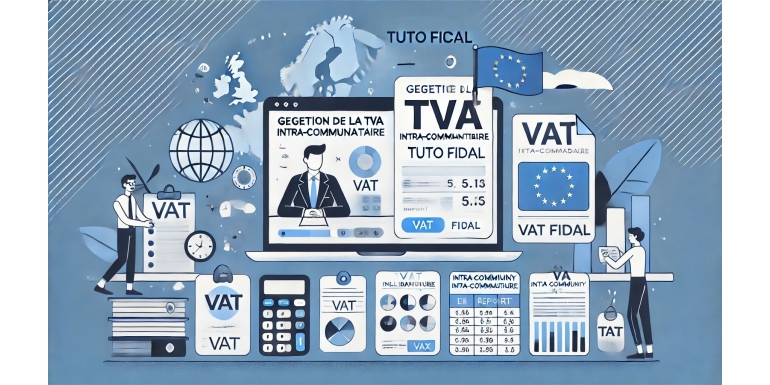
Managing intra-community Value Added Tax (VAT) is a critical aspect for businesses operating within the European Union (EU). Dolibarr, an open-source ERP and CRM solution, offers robust features to handle intra-community VAT effectively. This tutorial provides an in-depth guide on configuring and managing intra-community VAT in Dolibarr, ensuring compliance with EU regulations and streamlining your fiscal operations.
Understanding Intra-Community VAT
Intra-community VAT pertains to the taxation rules applied to transactions between EU member states. When goods or services are sold from one EU country to another, specific VAT rules apply:
-
B2B Transactions: If both the seller and buyer are VAT-registered businesses in different EU countries, the transaction is typically exempt from VAT in the seller's country. The buyer accounts for the VAT in their own country under the reverse charge mechanism.
-
B2C Transactions: If the buyer is a private individual or a non-VAT-registered entity, the seller must charge VAT at the rate applicable in the buyer's country, subject to certain thresholds.
Properly managing these scenarios in Dolibarr ensures accurate invoicing and compliance with tax authorities.
Configuring Dolibarr for Intra-Community VAT
1. Activating VAT Management
To begin, ensure that VAT management is enabled in Dolibarr:
-
Navigate to Home > Setup > Modules.
-
Activate the Tax module by clicking on the corresponding checkbox.
-
Confirm the activation to enable VAT functionalities across Dolibarr.
2. Setting Up VAT Rates
Define the applicable VAT rates for your operations:
-
Go to Home > Setup > Dictionaries > VAT Rates.
-
Click on New VAT Rate.
-
Enter the following details:
-
Label: e.g., "Standard VAT 20%".
-
Rate: e.g., "20.000".
-
Country: Select your country of operation.
-
Status: Set to "Active".
-
-
Save the new VAT rate.
Repeat this process to add all relevant VAT rates, including zero-rated VAT for intra-community B2B transactions.
3. Configuring Customer Records
Accurate customer information is vital for correct VAT application:
-
Navigate to Third Parties > Customers.
-
Select a customer or create a new one.
-
In the customer's profile:
-
Country: Ensure the correct EU country is selected.
-
VAT Number: Enter the customer's VAT number, including the country prefix (e.g., "DE123456789").
-
VAT Subject: Set to "Yes" if the customer is VAT-registered.
-
-
Save the customer record.
Dolibarr uses this information to determine VAT applicability on transactions.
4. Verifying VAT Numbers
Validating customer VAT numbers is crucial for compliance:
-
Use the VIES (VAT Information Exchange System) to verify the validity of EU VAT numbers.
-
In Dolibarr, you can integrate a module that automates this verification process, ensuring that only valid VAT numbers are accepted.
5. Setting Up Products and Services
Assign appropriate VAT rates to your products and services:
-
Navigate to Products/Services > List.
-
Select a product or create a new one.
-
In the product details:
-
Selling Price: Enter the price excluding VAT.
-
VAT Rate: Select the applicable VAT rate.
-
-
Save the product.
This setup ensures that the correct VAT is applied during invoicing.
Managing Intra-Community Transactions
1. Creating Invoices for Intra-Community B2B Sales
When selling to VAT-registered businesses in other EU countries:
-
Go to Billing > Customer Invoices > New Invoice.
-
Select the appropriate customer.
-
Add the products or services being sold.
-
Dolibarr will automatically apply a 0% VAT rate if:
-
The customer is in a different EU country.
-
The customer has a valid VAT number.
-
-
Ensure that the invoice includes the note: "Intra-community supply, VAT exempt under Article 138 of the EU VAT Directive."
-
Save and validate the invoice.
2. Handling Intra-Community B2C Sales
For sales to private individuals in other EU countries:
-
Monitor your sales thresholds in each country. If your sales exceed the threshold, you may need to register for VAT in that country and apply the local VAT rate.
-
Configure Dolibarr to apply the correct VAT rate based on the customer's location.
3. Recording Intra-Community Purchases
When purchasing from suppliers in other EU countries:
-
Navigate to Billing > Supplier Invoices > New Invoice.
-
Select the supplier.
-
Add the purchased products or services.
-
Set the VAT rate to 0% if:
-
The supplier is in another EU country.
-
You have provided your VAT number to the supplier.
-
-
Record the VAT under the reverse charge mechanism in your accounting records.
Reporting and Compliance
1. Generating VAT Reports
Dolibarr provides tools to generate VAT reports:
-
Go to Accounting > VAT Reports.
-
Select the reporting period.
-
Generate the report to view:
-
VAT collected on sales.
-
VAT paid on purchases.
-
Net VAT payable or reclaimable.
-
Ensure that these reports are accurate and submitted to the tax authorities as required.
2. Intrastat and EC Sales Lists
For statistical and compliance purposes:
-
Intrastat: Report the movement of goods between EU countries.
-
EC Sales List: Report sales of goods and services to VAT-registered businesses in other EU countries.
Dolibarr can be configured to generate these reports, or you can export the necessary data for submission.
Best Practices
-
Regularly Update VAT Rates: Ensure that your VAT rates are current and reflect any changes in legislation.
-
Validate Customer VAT Numbers: Regularly verify the validity of customer VAT numbers to maintain compliance.
-
Maintain Accurate Records: Keep detailed records of all intra-community transactions for auditing purposes.
-
Consult Tax Professionals: Seek advice from tax experts to ensure that your VAT management aligns with current laws and regulations.
Conclusion
Effectively managing intra-community VAT in Dolibarr requires careful configuration and ongoing attention to detail. By following this comprehensive tutorial, you can ensure that your business remains compliant with EU VAT regulations, minimizes the risk of errors, and maintains accurate financial records. Regularly review your settings and consult with tax professionals to adapt to any changes in legislation or business operations.
